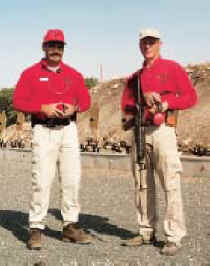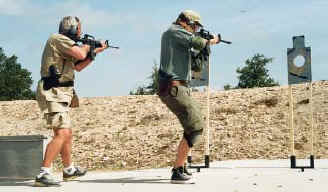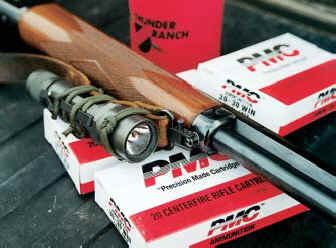NOT SO URBAN RIFLE
Thunder Ranch With A Twist
By Ashley C. Emerson
This past Spring I found myself once again in school. It was Thunder Ranch and the class was Urban Rifle. I had been to Thunder Ranch on several occasions before, but this was to be my first class. I was previously impressed with Clint Smith and his Thunder Ranch school—I was to become even more impressed in the next five days.
I knew most folks would be using AR15 type rifles. 'Cause I am me, and am much more likely to have one of my lever guns at hand when I need a rifle, I chose a Marlin .30-30. I ran this by Clint (who is interested in tried and true but seemingly obsolete firearms technology) and he said there would be no problem except that I would be real busy. Of course I couldn't use any of the stack of .30-30s that I already had. Thinking the extra round of capacity and the extra weight of an octagon barrel might help further with the already mild recoil (and because I didn't have one in .30-30) I trotted down to the local gun store and bought an off the shelf Marlin 336 Cowboy in .30-30.
Knowing what I know about Marlins, I took the gun to Dave Clay to have some reliability work done on it. We also installed a large (.230 inside diameter) aperture, adjustable rear sight (special non-cataloged low profile version) and a front sight with a .050 white stripe on a .100 wide face dovetailed into the barrel. I designed these sights several years ago. They are now available from Express Sight Systems, formerly AO Sights, formerly Ashley Outdoors. (I am no longer involved with the company.) I feel strongly that these sights, when correctly mounted, are your best bet for an iron sighted rifle. If you want these sights on your AR-15 and you have a short sight radius gun I would go with a front blade with the .030 white line on a .080 wide blade. Forget the tritium dots on your AR, they will most likely screw with your brain to the point that you cannot reliably make a hundred-yard head shot.

The five-day course at Thunder Ranch began with the first half of Monday being spent in the classroom. The first hour or so is spent filling out paperwork and meeting the staff. The rest of the morning is Clint's lecture on gun safety, tactics and rifle theory. Clint's combination of talent and experience, both in the field and as an instructor, really shines in the classroom. He is absolutely at home and speaks with authority in a polished yet entertaining way. In well over a quarter century of training all over the place, Clint has seen and taken in a lot. He shows the capability to embrace new technology that seemingly works and holds onto old techniques and old technology that have been proven to work. And unlike some in his field, Clint can let go of the old when experience shows there is a better way.
The training staff on hand was also very impressive, representing a combined total of more than one hundred years police and firearms training experience. All were very professional and well mannered in the presence of students. They all have trained with Clint for years and several of them have been involved with Thunder Ranch since the first year it opened.
While the staff all had police/firearm backgrounds, the students came from all walks of life. Occupations included: a firefighter, a geologist, a surgeon, a salesman, a guy in pharmaceuticals, one in commercial insurance, an engineer, an investor, a writer/school teacher, a microbiologist, a business executive, a corporate division manager, an FBI agent, a Texas Parks and Wildlife agent, three pilots, a CPA, a civil engineer (hwy. design), a lawyer (we let him stay anyway), three police officers and myself.
Experience levels were equally diverse at the start of the school with the beginners making great strides to close the gap by week’s end. Interestingly, the two that started with the least rifle experience were going to stay the following week for Urban Rifle 2. I suspect these men will go home sore and tired, but will be better men for their effort not to mention pretty fair riflemen. How much of a rifleman would any of us be today if we had gone through this much training under the watchful eye of such master trainers at the very beginning of our rifle shooting days?
On the first afternoon we sighted in with our own chosen point of aim and then fired at different ranges to see how range affected the point of impact. We shot from the same place in line each day and had the guy next to us as a partner. I was partnered up with Officer Nice from Portland, Oregon Police Department. This was fortunate for me because he had his act together while I was doing well to remember to constantly top off my lever gun while trying to keep up with what the instructors were saying.
You may be a redneck if .......Past experience has shown that you always learn new tricks at a school, so I expected to learn something. However, I didn't expect to learn so much about ARs. This would be great even if I didn't have one. First, it's info I can pass to my tribe on how to run our AR. If things ever go really bad in my lifetime there is a fair chance there will be a lot of weapons of this type around with a pile of ammo to go with them. Another area of new knowledge has to do with tactics, specifically inside a building. Clint has a building known as the Terminator and it has a variable floor plan with up to 400 variations. This is the place to learn corners and doorways. Instructor Rick Furr (distant cousin of friend and instructor Jack Furr) pointed out an error in my footwork in the Terminator. He told me what I should be doing and I still didn't see the advantage. Thanks to him taking the time to explain and demonstrate, I now have a refinement on my tactics. Thanks, Instructor Furr. It dawned on me as I left the Terminator that every time I had asked a question it had been answered with solid information instead of some "I don't really know why, it's just the way it's done" B.S. Besides being, to a man, the most polite, well-mannered and respectful group of instructors I have ever been around, they all seemed to have a rock solid grounding in their subject.
I have taken great pride in the fact that I could shoot well from about any field position. I have been practicing all types (I thought) of field positions for years. Boy was I surprised to learn some new (at least to me) things about squatting and sitting.
First, squatting. I never cared for the squat position myself and so I hadn't even tried to use it for over twenty years. I realize
two-thirds of the world uses it three quarters of the time, but I always thought I was better off in some kind of kneeling position. I don't know if it's the wrecked ankles or what, but it turns out I can't properly get my feet flat on the ground to do a correct squat. Interestingly to me is that my youngest daughter just naturally started using a squat position because she could not hold her .22 up off-hand (she only weighed 45-50 pounds when she started shooting at eight years old), and in our country there are lots of stickers and bugs and stuff. This was her natural modification to daddy's advice to get low to get steady when she didn't want to risk stickers. I learned how it should be done so I can show the rest of the tribe.
The next thing I learned, and this one blows my hair back, is that I had adopted an open-leg, sitting position as being the one I went to when sitting was appropriate. About twenty-five years ago I decided I didn't like shooting or sitting crosslegged. Because of this I hadn't tried cross-legged sitting in over twenty years. I guess when your age nearly doubles, some things change you might want to check on. It seems to me that it used to bother my ankles to sit cross-legged for any length of time. In the last twenty years at one time or another I have tried real hard to break both feet off with motorcycles and large bovine. Now cross-legged sitting is totally painless— actually comfortable and solid. I shoot nearly as well as prone. Add a shooting sling and I'm sure I can hold near a minute of angle. How long would I have gone not realizing this?
Much of what was taught in Urban Rifle I already knew (or should have known) from previous training. This kind of knowledge is the kind that you better use or review, or you will lose. Much of it crosses over into the other shooting disciplines and to fighting in general. What amazes me is that by the end of the fourth day I had learned how to make myself a smaller and better balanced target through the magic of improved footwork. I had also become a significantly better shot with the discovery that I could, more comfortably than any other sitting position, sit cross-legged for extended periods and have a very stable shooting platform.
On the last day of the course we worked on everything—the square range, the Terminator, the Charger, the Tower and Thunderville. On the square range we practiced the basics. In the Terminator it was more doors, corners and bad guys. The Charger was new to me, although I had seen it before.
The Charger consists of silhouette targets that can charge you at the operator's discretion. Officer Nice and I dealt with this as a team. What a blast! Clint started them charging with a hog squeal to make me feel at home. At the charge I went cyclic and levered nine rounds through the target as I ran backwards about twenty feet at which point Officer Nice covered me for the reload as he had done many times that week. I even got to riddle his target when he was charged while I was covering his reload. If this kind of stuff doesn't get your blood pumping and put a smile on your face check the mirror for a bullet hole in your forehead.
A short while later we were at the Tower and Thunderville. These two structures can be used separately or together. The Tower is a four-story structure consisting of your basic concrete rat maze with all kinds of different stairs, ladders, and windows—windows with different heights, angles, sizes and, oh yeah, bad guys. The Tower was designed so you can shoot in it or from it.
Thunderville is a Main Street Texas town. The middle of the main drag is only a long pistol shot from the
Tower. The thing with Thunderville is it would have helped if I had been in better shape (or maybe he would have just run me harder). The shooting problems were not that hard, it's just that breathing so hard that your chest is pounding is a bit of a distraction. Did I mention running to the Tower, climbing an exterior ladder to the first roof, running down inteior, uneven stairs in relative darkness, looking for bad guys then back out in the sunlight to ditch your bullet proof vest, pick up your gun, and run (while loading) up a ramp to start shooting targets that pop up across the street? You run from window to window, down stairs, through tunnels, on top of boxes, up through holes in the ceiling, slide down poles and shoot through more windows. Catch a breath and say to yourself, "Self, I will start eating right and exercising regularly".
If you are a rifleman this course will make you a better one. If you are not a rifleman it will make you a better fighter and a harder target after you learn what you are up against. You probably will not be able to pick the circumstances of the fight, likely not even your choice of weapons, certainly not your opponents.
In an industry that is so diverse as the shooting school industry is, Clint Smith, his staff and Thunder Ranch stand out as a "Camelot on its best day". The experience of going to a shooting school will likely never be better and the possibility to do it won't last forever. Get into any Thunder Ranch course you can and let the experience become part of who and what you are.
Para cord light mount - you gotta do what you gotta do

Left - Harry Fleming
Right - Clint Smith
SOURCES: Thunder Ranch, Inc.
HCR 1, Box 53
Mt. Home, TX 78058
(830) 640-3138 809
http://www.thunderranchinc.com/David Clay
Harris Road
Arlington, Texas 76001
(817) 465.7338
http://www.drccustomgunsights.com/PMC/Eldorado Cartridge Corporation
P.O. Box 62508
Boulder City, NV 89005
(702) 294-0025
http://www.pmcammo.com/Marlin Firearms Company
100 Kenna Dr.,
P.O. Box 248
North Haven, CT 06473-0905
(203) 239-5621
http://www.marlinfirearms.com/
Copyright S.W. A .T. Magazine • NOVEMBER 2002
Reprinted by Permission
http://swatmag.com


